Have you ever wondered how plants eat or drink? How do they get energy? Well, just like we need food and water to live, plants do too. However, unlike humans, they make their food from sunlight and carbon dioxide! How? They do it by a process known as photosynthesis.
This article will explore photosynthesis and learn the difference between chemical compounds like carbon dioxide, sugar, and energy. We’ll look at how plants store energy as starch.
What is Photosynthesis?
Plants and a few other organisms “put together” organic matter from carbon dioxide and water, using the energy of sunlight to power the process.
It is derived from the Greek word, ‘photo’ meaning light, and ‘synthesis’ meaning putting together.
Plants are the basis for almost all life on Earth: animals (including humans) either eat plants or eat other animals that eat plants. Also, plants provide us with oxygen.
Ingredients for Photosynthesis
When you’re hungry, you may ask your mom for food. However, plants can’t do that. So, they use the nutrients and water present in the soil, light energy from the sun, and Carbon Dioxide from the air to form a compound called glucose.
Glucose is a sugar that plants need to survive on. It’s their form of food, like you eat rice or noodles, they consume glucose for energy!
Why is photosynthesis important for life?
All living organisms on Earth are dependent on photosynthesis. Plants would not survive without photosynthesis, and thus, neither would animals that depend on the plants for food. Autotrophs, like plants and algae, produce glucose through photosynthesis.
Animals cannot do this. Therefore, they eat plants and use this energy in the process of cellular respiration. Otherwise, they get their energy through organisms that feed off autotrophs.
Organisms, who cannot synthesize their own food independently, are known as heterotrophs. These include:
- Herbivores such as cows and deer, who eat plants.
- Carnivores such as lions and wolves, who eat other animals.
- Omnivores such as humans and bears, who eat both plants and animals.
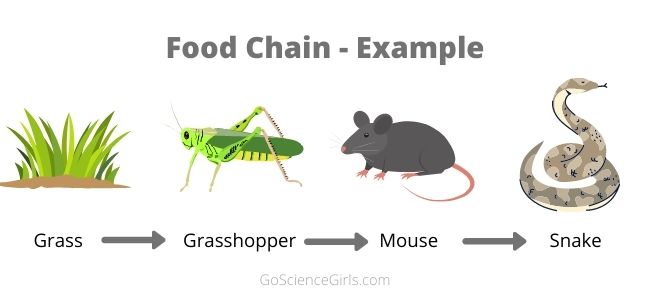
So, the plants are the start of all food chains and sustain all organisms. For example:
How Green Plants Make their Food
Green plants carry out photosynthesis by using a special green pigment called chlorophyll.
The chlorophyll inside the leaves captures the energy from sunlight, combines carbon dioxide with water, and makes sugar (glucose).
The plant transports this simple sugar to every part of its body. All in all, the steps involved in this process are:
● Absorption of Light Energy
Have you seen the sunflower plant moving towards the sun when kept in the shade? This is because the trapping of light energy is key to the process of photosynthesis.
Without sunlight, there will be no energy to make food. So, the first and most crucial step is that the chlorophyll in green plants absorbs sunlight.
● Conversion of Light Energy to Chemical Energy
Plants cannot directly utilize sunlight. So, they convert it into ATP (Adenosine TriPhosphate), a form of chemical energy.
When sunlight is absorbed, the chlorophyll atoms become photochemically excited and lose an electron, thus undergoing a process known as oxidation.
This electron is then used to convert non-usable sources of energy such as ADP and NADP+ compounds to primary chemical energy sources such as ATP and NADPH.
Then, to replace the electron lost in by the photochemically excited chlorophyll, the water absorbed by the plants splits into its two components- Hydrogen and water.
Since, hydrogen has only one electron, it breaks into protons and electrons, and then it uses the electron to bring the chlorophyll back to its original state.
This completes the process of conversion to immediate chemical energy, which is used to form glucose.
● Conversion of Carbon Dioxide to Glucose
When the water splits into hydrogen and oxygen, it undergoes an oxidation reaction as it loses Hydrogen. Similarly, carbon dioxide undergoes a reduction reaction as it gains electrons. So, as a result, water is converted to oxygen gas, and carbon dioxide is converted to glucose.
This is known as a redox reaction. Observe the following diagram to understand it better. A is water converting to oxygen, and B is Carbon Dioxide converting to simple carbohydrates (glucose) in photosynthesis.
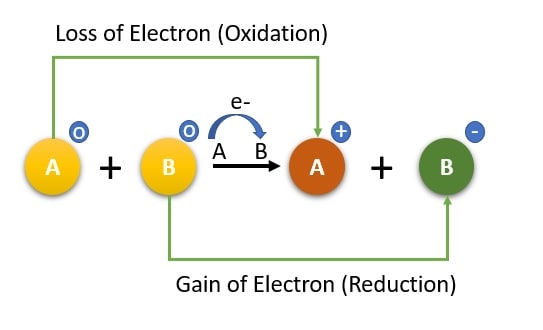
Photosynthesis Chemical Reaction in Words
Now that you understand how reactions occur and the resultant products are formed, it’s essential to know how to put them into words. One glance over this summarises everything explained above- that is what a chemical formula does!

The above equation represents the following chain of processes:
- Sunlight coming in contact with the chlorophyll in the thylakoid membrane of the chloroplast.
- Chlorophyll molecules get excited, and water splits into hydrogen and oxygen.
- Electrons from hydrogen (from the water) combine with Carbon Dioxide. This process is known as reduction, and glucose is formed.
- Oxygen is a by-product. Since it is of no use, it is excreted or thrown out from the cell.
Chemical Reaction Formula for Photosynthesis
Physical chemistry can be tricky because there are so many terms and factors to keep track of. So, you must understand these simple equations before you are allowed to work with natural chemicals.
A chemical equation is simply a list of all the chemical reactants and products and their relative quantities at its heart.
Chemicals are complex systems that can exist in very different states. Nonetheless, they can easily be represented as simple lists of these elements and their numbers. So, one can describe photosynthesis as:
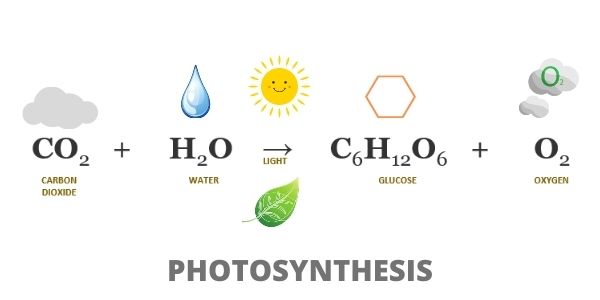
However, this isn’t a balanced equation. According to the Law of Conservation of Mass, mass can neither be created nor destroyed. Count the number of Carbon atoms on the reactant side (the left side.)
Now, count the number of Carbons on the product side (the right side.) One carbon can’t magically turn into six carbons, right? So, to rectify it, form a balanced equation of the reaction.
6CO2 + 6H2O → C6H12O6 + 6O2
Note that the number before the Carbon Dioxide, Water, and Oxygen represents the individual compound molecules.
Therefore, the number of Carbons on both sides of the equation is 6, oxygens are 18 (twelve from Carbon Dioxide and six from water), and hydrogens is 12.
Since the total number of atoms from each element are equal on the reactant and product side, this is now a balanced equation!
What does photosynthesis produce?
The release of chemical energy due to the formation of ATP and NADPH compounds, and the synthesis of oxygen, are light-dependent reactions.
However, a series of light-independent reactions- constituting the Calvin Cycle, actually form the food.
How is glucose formed? Does excess glucose undergo some changes? Read to find out.
The Calvin Cycle
This cycle consists of a series of light-independent reactions- which means they do not directly require sunlight to work. So, they can take place at night or day. They include:
- Carbon Fixation
One of the most critical functions of carbon is that it can be converted from Inorganic compounds (carbon dioxide in the atmosphere) to organic compounds such as G3P and glucose. This process is known as Carbon fixation.
Before glucose is formed in plants, first, they synthesize an intermediate compound known as glyceraldehyde-3-phosphate. Here, the carbon from carbon dioxide is used to manufacture G3P- C3H7O6– a three-carbon molecule.
- Formation of glucose and other carbohydrates
G3P is a raw material used in the formation of glucose. The Calvin Cycle involves 18 ATP and 12 NADPH molecules to synthesize one molecule of C6H12O6 (glucose).
It’s also used to form starch, sucrose, and cellulose, depending on the plant’s needs.
Starch also plays a significant role in nutrition in animals. When animals eat plants, their digestive processes break down the starch present to form glucose again.
This glucose is then used as a source of energy for metabolic processes. So, the starch in animals sustains the plant, the herbivore, the carnivore, and the decomposer.
What happens to excess carbohydrates which are not utilized immediately?
When carbohydrates are not utilized immediately, they are stored in various parts of the plant’s body in the form of starch. It’s a polysaccharide- a compound formed by binding a chain of
glucose molecules together. It stores a significant amount of energy for cell metabolism.
The stored starch gives the cell energy to perform all the processes necessary for its survival. Any unused energy is stored as a fat deposit.
Factors that affect the Rate of Photosynthesis
Just as human beings need various nutrients to survive, plants need several environmental conditions for photosynthesis to happen appropriately.
Even if one of the optimum requirements is affected, so is the rate of photosynthesis in plants. So, photosynthesis is based upon several factors. They include:
1. Light Intensity
If the light energy provided to plants is too low, the plants cannot photosynthesize properly. At the optimum amount of sunlight, the plant makes the food faster.
However, the speed slows down again if the light energy given increases above the plant’s maximum tolerance level. In winter or colder areas, the rate decreases and falls to zero at night.
Therefore, light intensity plays a vital role in the rate of photosynthesis.
2. Carbon Dioxide Concentration
Up to the maximum tolerance of carbon dioxide in plants, increasing the amount of exposure to gas maximizes the rate of photosynthesis.
After that, increasing carbon dioxide concentration in the air will not affect the plants.
This is because the plants can only intake a certain amount of carbon dioxide to convert into glucose. So, one can represent the rate of photosynthesis as:
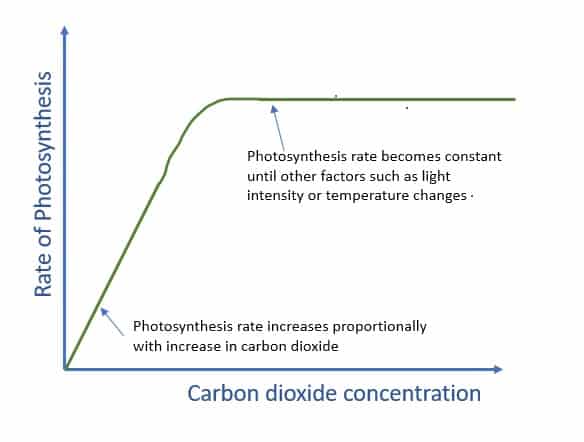
3. Temperature
In photosynthesis, a lot of enzymes need to work to fulfill the requirement of energy. However, they can only work at the optimum temperature.
Raising the temperature increases kinetic energy. So the molecules start moving at a higher speed and collide faster, increasing the rate of photosynthesis.
Like in all the other cases, very high temperature is just as bad as very high temperature. In both cases, the enzymes will gradually be destroyed, and the photosynthesis will eventually stop.
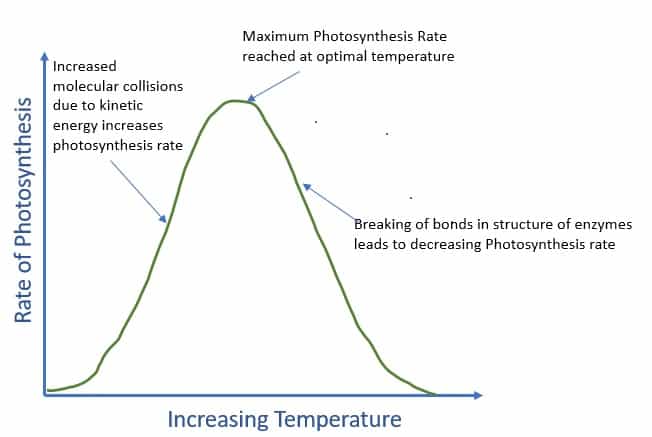
Energy Result of Photosynthesis
As we have seen, there are two types of reactions in photosynthesis- the light reactions and the dark reactions.
The light-dependent processes synthesize energy in the form of ATP and NADPH.
The dark reaction uses already made energy to manufacture glucose and other carbohydrates, which are further used in metabolic processes required for the plant’s survival.
So, let’s look at these chemical processes from the perspective of energy used and released.
1. Light-Dependant Reactions
Sunlight gives plants the energy to photochemically excite the chlorophyll, which leads to the splitting of water. This allows the conversion of ADP and NADP+ molecules into ATP and NADPH, which can be used in other processes.
2H2O + 2 NADP+ + 3 ADP + 3 Pi + Light Energy → 2 NADPH + 2 H+ + 3 ATP + O2
2. Dark Reactions
The energy synthesized in the light-dependant reactions is used to reduce carbon dioxide and form glucose. The carbon fixation process takes place here; that is, the carbon gets converted from an inorganic form to an organic compound.
3 CO2 + 9 ATP + 6 NADPH + 6 H+ → C3H6O3-phosphate + 9 ADP + 8 Pi + 6 NADP+ + 3 H2O
Further, it takes 18 ATP and 12 NADPH compounds to convert the G3P molecule into glucose.
3. Respiration
When the glucose molecule is formed, the plant performs a process known as respiration. The glucose molecule is combined with oxygen and breaks down into carbon dioxide and water.
In this process, a considerable amount of energy is released.
This energy is used to help the plant perform all its metabolic functions needed to survive. It’s a constant cycle, which the following diagram can explain:
How Do Plants Absorb Energy From the Sun?
As we’ve seen, photosynthesis cannot take place without energy from the Sun. So, the plants have a mechanism set in place to observe light energy.
This is done by the pigment chlorophyll, present in chloroplasts, present in the cells of green leaves of plants. Let’s look at the structure of the chloroplast to help you understand.
Sunlight has a lot of components. All the parts have a certain amount of energy. The main components of sunlight used by the plants are blue, red, and green.
With the thylakoid’s help in the chloroplasts (observe the diagram), which contain chlorophyll, the light energy is absorbed—specifically, the blue and red components.
The green is reflected into the environment. Now, can you answer the question, ‘why do plants look green?’ It’s because of the reflected green light!
Look at the diagram again. Can you see that the thylakoids are present in stacks? These are known as grana, which is the site of converting light energy to chemical energy!
The aqueous fluid surrounding them is known as the stroma. The transformation is completed here.
Where Do Plants Get the Carbon Dioxide Needed?
Just like we breathe through our noses, plants have millions of tiny openings on the surface of their leaves. These are known as stomata.
These stomata pores are protected by a pair of guard cells, which regulate the opening and closing of these pores.
When they do open, the atmosphere’s carbon dioxide flows through the stomata, from where it’s sent to the chloroplast- the site of photosynthesis.
Various environmental stimuli control the guard cells. When all the optimum conditions (water and sunlight) are present, the guard cells swell and curve.
This movement is because it takes in water through a process known as osmosis, which triggers the opening of the guard cells and allows the carbon dioxide to enter.
At night, when there’s no light or the plant wants to conserve water, the stomatal pores lose water through osmosis.
This causes the stomata to become straight, and once again, they are closed. One can also show this process with a diagram:
Why Do Plants Produce Glucose?
Now that we know how plants produce glucose, it’s essential to understand why? Why are these six-carbon molecules so crucial for life? Let’s find out.
1. Storage
Sun is essential for the release of energy. Therefore, during the winter or the night, when there is not enough sunlight, the plant uses the glucose stored in various parts of the plant.
The process of respiration takes place, and the energy for metabolic processes is released without the presence of the Sun.
Without the stored glucose, the plant would’ve died during the night or the long winters.
2. Seed Formation and Flowering
Glucose is stored in the seed in the structures known as cotyledons. They allow the seedling to stay alive even deep inside the soil, without leaving to synthesize food.
Furthermore, they provide the energy required for germination and encourage leaf growth. Moreover, glucose stored in some plants also helps in the flowering of some unique plants.
Hyacinths, daffodils, and tulips are some plants that depend upon the glucose to flower. These beautiful flowers attract pollinating agents towards them, which helps the plant to reproduce.
3. Formation of other nutrients
Several glucose molecules combine to form starch- a complex carbohydrate present in plants.
They also react with nitrates present in the soil to form amino acids, which eventually form proteins. Carbohydrates and proteins are major nutrients for both humans and plants.
Thus, glucose plays an essential role in nutrition.
4. Circadian Rhythms
Plants need to maintain their body temperature and stay in tune with the day-and-night cycles. So, the formation of glucose in the day and respiration during the night helps the plant to maintain its daily clock and energy reserves.
How Do Plants Eat?
Now, since glucose has been synthesized, the next step is transportation and utilization. So, the sugar is transported through various parts of the plant, where it’s needed.
A vascular tissue known as phloem accomplishes this movement.
Then, similar to humans, cellular respiration takes place in plants as well. Plants convert glucose and other sugars, in the presence of oxygen, into energy.
Carbon Dioxide and water are by-products of this process. Just like you need the energy to breathe, walk, run, study, and survive- plants need it for:
- Growth processes
- Making more food
- Other cellular maintenance functions
So, just like we eat our food, plants synthesize glucose and other carbohydrates and convert them to energy!
Since it doesn’t require light energy, it can take place during the day or the night. So, the plant doesn’t starve.
Role of Leaves in Photosynthesis
Leaves are sites of photosynthesis. So, they have a series of features that help them perform their function efficiently. Leaves have adapted to the environment in various ways, such as:
- Large Surface Area
Broader leaves can absorb more light energy and thus, increase the surface area for photosynthesis.
- Shorter Width
The leaves are thin so that the absorbed carbon dioxide has to travel a short distance to reach the chloroplasts (sites of photosynthesis).
Otherwise, a considerable amount of energy would have to be spent on CO2 transport, which the plant couldn’t afford.
- Veins
Observe the given diagram. Have you ever touched a vein? Is it harder or softer than the surface of the leaf?
Veins in the leaf provide support, and transport food, water, and minerals as well. They are extensions of the vascular bundles- Xylem (which transports water and minerals) and Phloem (which transports synthesized food.)
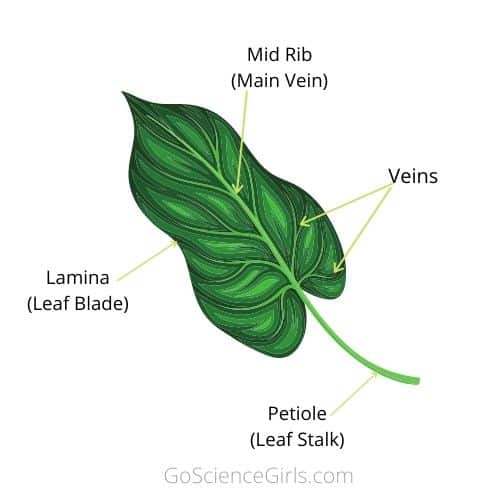
- Chloroplasts
Of course, the main adaptation of leaves is the chloroplasts with the pigment chlorophyll inside of them.
These absorb light energy, then convert it into a usable form- chemical energy. Without these small components, photosynthesis wouldn’t take place, and life wouldn’t exist.
Role of Water in Photosynthesis
- Converts NADP+ to NADPH
When photosynthesis takes place, water splits into its components- hydrogen and oxygen. The H+ ions are then used to reduce the NADP molecules to NADPH molecules, which can be used to synthesize glucose. It also eventually leads to the formation of ATP- the energy currency of the cell.
- Provides Oxygen
The oxygen, which is obtained from the splitting of water, is released into the atmosphere and used by animals and humans for respiration. Most living organisms on the face of this planet need this oxygen released by plants to survive.
- Reduces chlorophyll
When the sunlight hits chlorophyll, it becomes photochemically excited, loses an electron, and undergoes oxidation. So, to return to its original state- water donates an electron and acts as a reducing agent.
Do All Plants Photosynthesize?
We sometimes look at photosynthesis as the defining characteristic in plants. However, there are some plants, which do not have chlorophyll and do not perform photosynthesis.
Instead, they choose to get their energy by stealing from their neighboring plants. These are known as holoparasites.
They are entirely dependent on their host and obtain nutrients required from living off of them. So, they do not need to perform photosynthesis, but the host eventually dies due to the continuous stealing of nutrients by the parasites.
Photosynthesis in Oceans
Have you ever wondered how marine plants perform photosynthesis in seas or oceans, where there is a limited amount of light and carbon dioxide?
So, most marine plants stay near the surface of the water to fulfil their requirements. Furthermore, chemical molecules known as phycobiliproteins are present in some tiny organisms known as cyanobacteria, which absorb the light available in the ocean and convert it into light energy that the chlorophyll can use.
Marine organisms release half the Earth’s oxygen, even though their biomass is less in magnitude than bulky terrestrial organisms. They reproduce faster, a new generation every day or two! More significant numbers help in the process of photosynthesis as well.
Science Experiments that Prove Photosynthesis in Plants
Experiments on photosynthesis in plants are fascinating. Children will soon find out that there is no need to fear biology because it’s been fun all along. The four experiments on photosynthesis in this article will create joy and excitement among children who love science.
Experiment #1
Aim: To prove that plants need sunlight to grow
Materials Required: A potted plant, a boiling tube, 70% alcohol, iodine solution, bunsen burner, forceps, beaker, water, dropper, black paper, and a petri dish.
Procedure:
- Place the potted plant in the dark for about 72 hours. This inhibits the process of photosynthesis, and all the leaves become free of starch.
- After three days, take a strip of black paper and put it on a section of one of the potted plant leaves on both sides.
- Put the plant in the sunlight for a few hours.
- Detach the partially covered leaf from the plant and remove the black covering.
- Boil this leaf in a 70% alcohol solution using a bunsen burner until it loses its green color. This is because we are removing chlorophyll.
- Wash the leaf with water and add iodine solution with a dropper.
- Observe.
Observation: The whole leaf turns blue-black, except for the section covered with black paper. This is because iodine changes color in the presence of starch. However, since the covered portion did not come in contact with the sun, it didn’t photosynthesize, and thus, starch wasn’t present.
Conclusion: We realize that plants need sunlight to photosynthesize and manufacture food.
Experiment #2
Aim: To prove that Carbon Dioxide is necessary for photosynthesis.
Materials Required: A healthy potted plant with long and narrow leaves, Potassium Hydroxide solution, 70% alcohol solution, a jar with a large mouth and cork, grease or vaseline, bunsen burner, petri dish.
Procedure:
- Place the potted plant in the dark for about 72 hours. This inhibits the process of photosynthesis, and all the leaves become free of starch.
- Open the jar and pour in a couple of millimeters of potassium hydroxide. This absorbs the carbon dioxide gas present in the atmosphere.
- After three days, choose a long and narrow leaf and put half of it in the jar.
- Seal the jar and make sure it’s airtight. Put grease on the corners of the cork.
- Put the plant in the sunlight for a few hours.
- Detach the leaf from the plant and boil it in a 70% alcohol solution using a bunsen burner until it loses its green color.
- Wash the leaf with water and add iodine solution with a dropper.
- Observe.
Observation: The half of the leaf exposed to the air turns blue-black due to the presence of starch. The other half was deprived of CO2, and therefore, it didn’t form starch.
Conclusion: Carbon Dioxide gas is necessary for the process of photosynthesis.
Experiment #3
Aim: To prove that oxygen gas is released during photosynthesis.
Materials Required: A large beaker filled with water, a short transparent funnel, pondweed, or an aquatic plant such as Hydrilla, and a test tube.
Procedure:
- Place a few twigs of the aquatic plant into the transparent funnel.
- Immerse the funnel into the beaker full of water.
- Now, fill the test tube until it’s almost overflowing with water. Cover the mouth of the tube with your thumb.
- Invert the test tube and put it over the funnel, as shown in the diagram.
- Place the setup in the sunlight.
- Observe until the test tube is completely filled with gas.
- Take out the test tube carefully without letting the gas out.
- Bring a burning splinter in contact with the gas. Observe.
Observations: After a few hours in sunlight, there are bubbles in the water, proving the presence of a gas. The burning splint reignites with a pop sound when it’s brought in contact with the test tube- confirming the presence of oxygen.
Conclusion: Photosynthesis releases oxygen.
The Conclusion
Next time you see a tree, stop to hug it. It does a lot of work to make sure that we, humans can live by being one of our resources.
Knowing how photosynthesis works and how it nourishes all the animals in the world should help us realize that plants give us life.
Learning about photosynthesis also explains what makes plants unique. With the information and activities in the article, you now understand what photosynthesis is; and what it means to the environment.

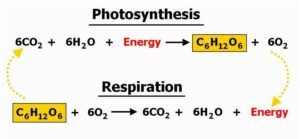


Dear Angela, Great article on photosynthesis. I could comprehend it easily. It’s explanation method was superb.